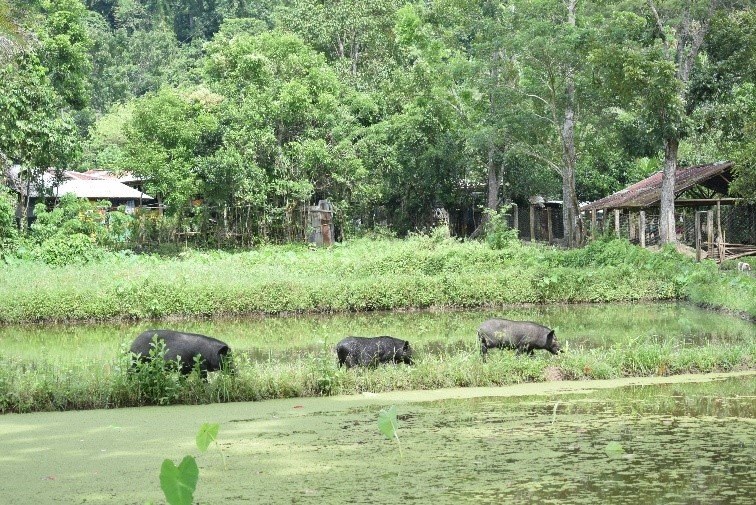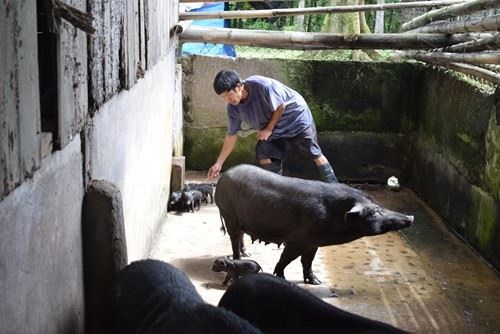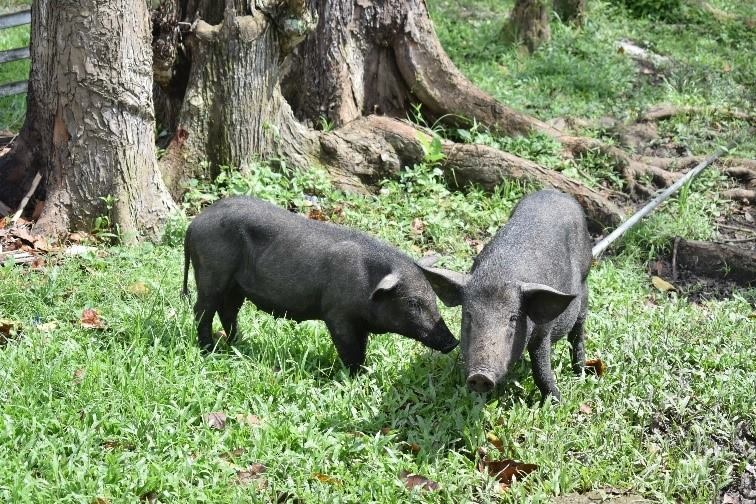LAMBUNAO, Iloilo – They used to be the main feature in fiestas and rituals.
They still are but their platform is no longer limited to tables. They are now in laboratories as subject of studies on organic meat for the health-conscious.
The Ligom pigs (Sus cebifrons) – belted, spotted, all-white or all-black – are the subject of study of researchers of the West Visayas State University-College of Agriculture and Forestry (WVSU-CAF) here where they are found to be far tastier and healthier to eat compared to their commercially bred cousins.
The Ligom pig is a breed of the more popularly known wild pig Filipinos know as “baboy ramo” but is all-black from the snout to the hooves, and has straight underline and minimal spine curvature. WVSU-CAF takes pride on the study on Ligom pigs in line with its interest on the conservation of wild animals.
“The WVSU-CAF Ligom breed of pigs were developed from 10 generations of line breeding of native pigs from the province of Iloilo. After 10 generations of line-breeding, it is imperative to characterize the WVSU-CAF Ligom pigs in terms of their production and reproductive traits,” says Lucia L. Lastimoza, dean and campus administrator who is also the thesis adviser of undergraduate researchers Arvin V. Subillaga and Pearl L. Celeste who studied Ligom pigs as source of healthy organic pork.
Line breeding is the mating of related animals, but not those closely related such as cousins or parents.

Ligom pigs are let loose to forage in the piggery surroundings of the West Visayas State University-College of Agriculture and Forestry in Brgy. Jayubo, Lambunao. The diet of Ligom pigs are all natural, making them a far healthier and more delicious alternative to commercial pigs.
Subillaga and Celeste’s study that was done from May to December of 2012 is said to be the first on the production and reproductive performance of Ligom pigs. They recommend that more studies should be done on the nutrient requirements of native pigs and their production performance.
Good source of income and easy to grow
The WVSU-CAF Ligom pigs that can be let loose to forage can also be raised in pens since they can be fed sloughs or cooked vegetables with simple concentrates at 65:35 ratio unlike commercial hybrid pigs which have to be fed with 100 percent concentrates, said Subillaga and Celeste who studied 47 Ligom piglets from the 10 pregnant sows in the piggery project of the WVSU-CAF.
“This could bring income to the indigenous people of the uplands of Panay who mostly raise native pigs, and to other entrepreneurs who would raise organic pork for the market,” the researchers said.
The income from raising pigs are well worth the effort with the 52.06 percent return on investment. A 157-day old Ligom pig grows to a marketable 20-kilogram weight.
The project maintains only one laborer cooking the feeds, feeding the pigs and cleaning their pens daily. The work, however, becomes more challenging during weekends and long vacations when students cannot assist in the care and management of the animals, or to help the laborer.
Ligom pork as bred by WVSU-CAF is not yet available in the Lambunao market, but live Ligom pigs, aging from eight months to more than a year old, can be bought at the University’s piggery at prices ranging from P2,500 to P3,500 per animal.

Three-day old Ligom piglets with their mothers are being cared for by caretaker Jerry “Engok” Lebuna at the West Visayas State University-College of Agriculture and Forestry in Brgy. Jayubo, Lambunao.
From laboratories to tables
“The piggery project has now more than 100 Ligom pigs, a venue of the agriculture students for their laboratory activities in my basic animal science subjects,” says Anthony L. Leal, the technical adviser of students Subillaga and Celeste.
Leal says Ligom piglets are cheaper laboratory animals compared to the hybrid ones, especially so that students have to procure or grow them so that they can later learn the correct slaughtering of swine and the castration of piglets as part of their laboratory activity.
WVSU-CAF’s professors and student-researchers were scientific in their claim that Ligom tastes better than your usual hybrid pigs sold as lechon and other pork-derived foodstuff.
Results of the taste evaluation showed that Ligom pork is “liked moderately to being liked very much” compared to commercial pork, says Leal who says the rating scales they used were the 9-Point Hedonic Rating Scale and the Food Action Rating Scale.
“Furthermore, evaluators responded that they would frequently eat the dishes prepared from Ligom pork,” says Leal who teaches Animal Science subjects and has worked at WVSU-CAF for seven years.
Pork and meat from year-old Ligom pigs are prepared as native Lambunao dishes such as La-uya (stewed pork), Tinu-om (entrails), Inasal (barbeque), and Binayabsan (pork belly chunks cooked with spices and soured with guava leaves).
On the other hand, grower Ligom pigs are prepared as lechon (roast pig), stuffed with banana leaves, lemon grass, and other native plants’ leaves such as batwan (Garcinia rubra), labog (roselle), alabihod (Spondias pinnata) or alumpiran (Ampelocissus ascendiflora).
Culled Ligom are slaughtered and their pork is used for meat processing and the preparation of sausages, pork loaf, and tocino among others.
WVSU-CAF is also looking at the possibilities of tanning of the skin of Ligom pork for leather products.
Anthony Leal can be contacted at: 09993339900, alleal36@yahoo.com
